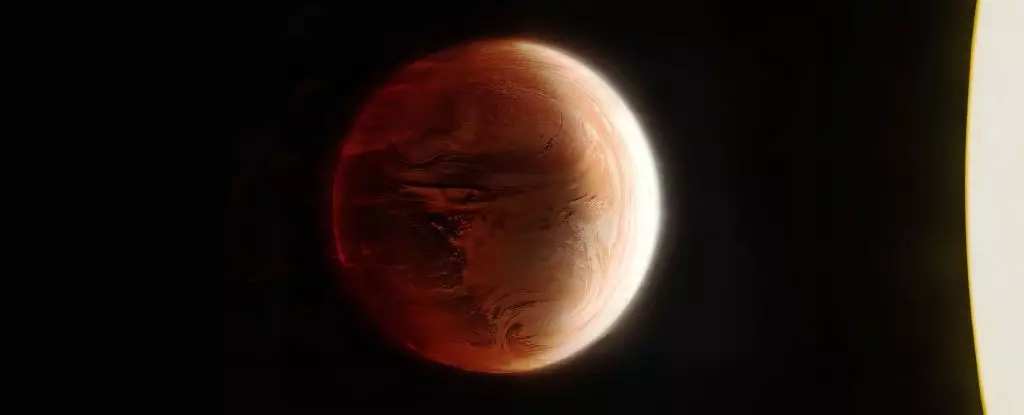A mere 880 light-years from our blue planet, the exoplanet Tylos, also known as WASP-121b, has piqued the interest of astrophysicists and astronomers alike. Unlike anything we might encounter within our Solar System, Tylos is classified as a “hot Jupiter,” a gas giant exposed to extreme temperatures due to its proximity to its host star. Featured by its spectacular weather phenomena, it presents both challenges and opportunities in our quest to understand planetary atmospheres and weather patterns beyond our own.
As researchers continue to unravel the complexities of Tylos, one striking feature stands out: its atmosphere. The exoplanet’s atmosphere is not merely warm; it is a boiling cauldron, dense with clouds of vaporized metals like iron and titanium. Surprisingly, temperatures soar to around 2,360 Kelvin (almost 2,087 degrees Celsius or 3,788 degrees Fahrenheit), pushing the boundaries of what we thought possible for a planetary environment. Such conditions are not only riveting but are also a playground for scientists looking to investigate extreme meteorological effects.
The discovery that Tylos rains liquid sapphires and rubies further lends a touch of surrealism to its already arresting profile, portraying an otherworldly atmosphere that seems to challenge the natural laws we understand. With successful observations made using the ESO’s Very Large Telescope, astrophysicists have made significant strides in reconstructing the intricate three-dimensional structure of Tylos’ atmosphere. This groundbreaking effort has allowed researchers to capture the dynamics of wind patterns and temperature variations, painting an astonishing picture of exoplanetary meteorology.
Among the maddeningly fascinating findings regarding Tylos are the unprecedented wind speeds recorded in its atmosphere. Researchers discovered powerful jet streams that whip clouds of metal across the skies at mind-boggling speeds. By observing these jet streams, it became evident that they can accelerate to astonishing velocities—reaching a speed of 26.8 kilometers (16.7 miles) per second at their peak, making it the fastest atmospheric jet stream ever documented.
Tylos is tidally locked to its star, meaning one side is perpetually exposed to the sun while the other remains in darkness. This unique rotation creates a stark temperature disparity, fueling wind patterns that can rival the strongest storms found within our own Solar System. Scientists have noted that the atmospheric conditions on Tylos may rival or even surpass the intensity of our planet’s most ferocious hurricanes, further solidifying its reputation as a phenomenon of nature.
Another enthralling revelation comes from the analysis of Tylos’ atmospheric layering. The findings indicate a sophisticated structure where different atmospheric layers interact in unexpected ways. The research showcased two significant types of circulation: one dominated by a jet stream flowing around the planet’s equator and another deep atmospheric movement transporting gases from the scorching sunlit side to the cooler night side. Such complexity, never observed before on any known planetary body, raises questions about the fundamental principles governing atmospheric behavior across celestial bodies.
The complexity of Tylos’ weather patterns challenges existing knowledge and prompts scientists to reconsider assumptions regarding atmospheric dynamics. For instance, the presence of sodium and hydrogen layers above the turbulent iron-laden atmosphere offers tantalizing clues about potential chemical interactions and energy transfer processes at play.
The implications of these findings stretch far beyond the context of Tylos. By understanding its extreme atmospheric conditions, researchers can glean essential insights into the broader universe of exoplanets, potentially studying the atmospheres of distant worlds in ways previously unimagined. This newfound capability has the power to redefine our understanding of not just gas giants but also terrestrial planets that might exist within habitable zones.
Astrophysicist Julia Victoria Seidel aptly remarks on the paradigm shift these findings represent, emphasizing the idea that Tylos forces us to expand our understanding of weather—both on Earth and across the cosmos. As research evolves, it illuminates the complexities lying in the dynamics of different exoplanetary environments, guiding the next stages of exoplanet exploration.
The study of Tylos offers a captivating glimpse into the extreme nature of planetary atmospheres and highlights the endless possibilities that await in the universe. It challenges previous notions about what is possible, igniting the spark of curiosity that drives scientists to explore further. The revelations surrounding Tylos encourage us to look beyond our Solar System, to a universe brimming with extraordinary worlds just waiting to be discovered.


Leave a Reply